Homeland security, home style
THREE TIME zones, 3,000 miles and a cultural galaxy apart, New York and Los Angeles -- along with Washington -- face a common threat: They are prime targets of Islamic terrorists.
On the face of it, two of the nation’s biggest metropolitan police forces seem to have adopted kindred counter-terrorism strategies. Both have roving SWAT, or “Emergency Service Unit,” teams equipped with gas masks and antidotes to chemical and biological agents. Both have set up “fusion” centers to screen threats and monitor secret intelligence and “open-source” information, including radical Islam Internet sites. Both have started programs to identify and protect probable targets. Both have tried to integrate private security experts into their work. Both conduct surveillance that would have been legally questionable before 9/11.
Yet despite such similarities, the terror-fighting approaches of New York and L.A., like the cities themselves, reflect different traditions, styles and, above all, resources. New York, which knows the price of failure and thus has a heightened “threat perception,” sets the gold standard for counter-terrorism -- and has the funding ($204 million) and manpower (about 1,000) to do it. Deploying its own informants, undercover terror-busters and a small army of analysts, New York tries to locate and neutralize pockets of militancy even before potentially violent individuals can form radical cells.
By contrast, in L.A., terrorism is a less-pressing concern than gang violence and other crime. Lacking the political incentive, and hence the resources, to wage his own war on terror, Chief William J. Bratton has pooled scarce funds, manpower and information with various government and public safety agencies -- a creative approach that federal officials hold up as a model for financially strapped police departments across the country.
In many ways, Los Angeles and New York might as well be on different planets. The sheer range of territory that Bratton’s roughly 9,550-member force and other law enforcement agencies must cover is daunting. “What is New York at its widest -- 40 miles?” asks Los Angeles City Councilman Jack Weiss, a champion of Bratton’s campaign for more funds and flexibility for the Los Angeles Police Department, especially its counter-terrorism efforts. “The city of Los Angeles alone is some 450 square miles.” The FBI’s L.A. field office must protect 18 million residents in seven counties, says its head, J. Stephen Tidwell.
Civic culture and history also constrain Bratton’s terrorism-fighting capabilities. The LAPD’s notorious resort to illegal surveillance in the past led to extremely tight legal restrictions on whom it could monitor, and for what kinds of suspected offenses. Bratton is trying to loosen those restrictions, but many Angelenos remain suspicious of the police. Most New Yorkers witnessed the 9/11 attacks, lost friends and relatives or knew people who knew victims, but for Angelenos, terrorism -- except in the L.A.-based TV show “24” -- is something that happens to others.
Of its $1.2-billion budget, the LAPD spends roughly $24 million on counter-terrorism.
Such limitations make Bratton’s progress on counter-terrorism since his appointment five years ago all the more remarkable. The department’s counterterrorism unit has 256 members, some of them borrowed from other divisions, with 21 positions unfilled.
The perpetual shortage of manpower and funds has made “sharing,” “jointness” and “force multiplier” Bratton mantras. He has relentlessly sought to forge closer ties with other law enforcement and public safety agencies in the region, particularly the FBI. The FBI’s Tidwell describes law enforcement cooperation in L.A. as “almost genetic,” a tradition forged by decades of joint responses to earthquakes, fires and floods that plague the Southland. On the Joint Terrorism Task Force squads, to which Bratton has assigned 15 officers, the FBI clearly leads.
And the Department of Homeland Security now has an official stationed full time at L.A.’s crown jewel of “jointness”: the Joint Regional Intelligence Center, or “Jay-Rick,” which both Bratton and Michael Chertoff, secretary of the department, hold up as a model for fusion centers soon to be operational in more than three dozen U.S. cities. Launched with a $4-million Homeland Security grant and opened last year in a federal building in Norwalk, the center has 30 staffers from federal and other local law enforcement agencies, including 16 from the LAPD. The analysts vet tips and leads -- nearly 25 a week, on average -- to identify the 1% that prove serious. If someone threatens to spread anthrax in the city, for instance, the center’s “threat squad” tries to figure out if the danger is real.
The Joint Regional Intelligence Center has its critics, however. The heavy workload troubles counter-terrorism experts, such as UCLA’s Amy Zegart, among others, who complain that officials “need to narrow the scope of inquiry to avoid more wild-goose chases rather than conduct them.” Experts also maintain that it’s hard to tell who leads the center, which is co-managed, in theory at least, by the LAPD, the Sheriff’s Department and the FBI. Other criticisms include the center’s remote location -- which makes it an unlikely assembly point in an emergency -- staffing shortages and difficulty obtaining security clearances in timely fashion.
A second pillar of the LAPD’s counter-terrorism effort is Operation Archangel (also financed by millions in federal Homeland Security funds), which uses sophisticated computer software to identify, prioritize and protect vulnerable targets -- so far, 500 of them, including Disneyland and nuclear plants, officials say. Archangel asks the owners and operators of these sites to provide the latest structural information -- floor plans, air-conditioning and electrical-system locations, entrances, stairwells and so on -- which goes into a huge database. Software then assesses vulnerabilities and devises deterrence and prevention strategies as well as emergency response plans.
But here too resources are limited. Archangel operates with just 15 people -- one-third its projected staffing -- and not around the clock. In addition, some private businesses are reluctant to associate openly with the program, fearing that being identified as targets will drive away tourists or business. Such concerns rule out L.A.’s adoption of the New York Police Department’s “in-your-face” exercises, like its random deployments of heavily armed police and vehicles to sites across the city.
The lack of public urgency means that Bratton must work doubly hard to get the counter-terrorism manpower, money and information that he needs. And that, in turn, has involved lots of travel, for which he has faced criticism. Staunchly defended by Mayor Antonio Villaraigosa, Bratton says the LAPD and the city benefit from the information and cooperation he gets from his travels. The explanation has satisfied most critics.
Continuing to promote “jointness,” Bratton is trying to get several cities to pool resources to station detectives overseas, as New York has for several years. These liaison officers would share their reports with those who helped finance their posts. Supported by the Manhattan Institute and the Department of Homeland Security, he is also planning a national police academy in Los Angeles to train police from cities across the country in intelligence-led policing skills.
Both the NYPD and the LAPD agree that a key way to crush incipient terrorist cells and thwart terrorism is to use local laws and follow locally generated leads, which, after all, is what good police departments do best. One of the LAPD’s most celebrated examples of the strategy is a 2005 Torrance case in which the arrest of two men for robbing a string of gas stations in that city eventually unraveled a militant Islamic plot to attack U.S. military facilities, synagogues and other places where Jews gather in Los Angeles County.
Another success, details of which haven’t yet been made public, is what the LAPD calls its “coming of age” terrorism case: the uncovering in the immediate aftermath of 9/11 of a group of French-speaking North Africans, then living in an apartment complex in Hollywood, who may have provided support to the 9/11 hijackers. LAPD investigators found “earmarks of a classic safe house” and eventually focused on a taxi driver named Qualid Benomrane, who they believe chauffeured two of the hijackers around L.A. and San Diego. The LAPD, using non-terror statutes but not wiretaps, succeeded in breaking up what it believes was an Al Qaeda cell. Its members have either been arrested on various criminal charges, deported or left the country voluntarily. (Neither the FBI, which helped investigate the cell, nor the 9/11 commission agreed with the LAPD that this was an Al Qaeda support cell.)
Because most U.S. cities’ counter-terrorism resources match L.A.’s more than they do New York’s, Bratton’s priority of pooling resources and information is likely to be a more attractive, if less ambitious, model than New York City’s approach. Washington has begun to acknowledge that thwarting terrorism requires better local intelligence about what potentially dangerous groups and individuals are planning. Last year, the Department of Homeland Security’s “Urban Area Security Initiative” began to offer grants to help local police strengthen their ability to collect and analyze intelligence. Our cities -- not only L.A. and New York -- will be safer for it.
More to Read
Start your day right
Sign up for Essential California for news, features and recommendations from the L.A. Times and beyond in your inbox six days a week.
You may occasionally receive promotional content from the Los Angeles Times.





